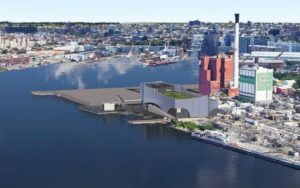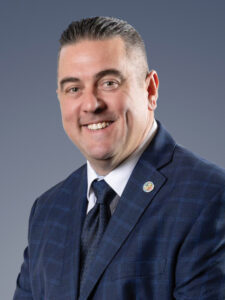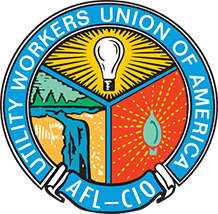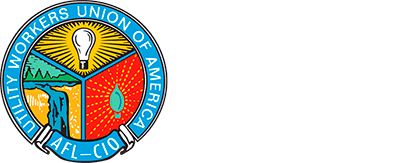In October New York’s governor approved three new wind farms off New York City’s shores, including one project that would shift Rise Light and Power’s (RLP) Ravenswood Generating Station to 100% renewable energy and another that will supply Con Edison’s planned Brooklyn Clean Energy Hub. Local 1-2 represents workers at both companies and has been meeting with both management and state regulators to ensure that its members are trained and ready for this work.
In all, New York now has five offshore wind projects in active development. Together, these projects are expected to produce 4,300 megawatts of electricity — or nearly 50% of the capacity needed to meet the state’s wind goal of 9,000 megawatts by 2035. The state and city are counting on these and other renewable projects to help fill the carbon-free energy void left following the 2021 shutdown of the 2000-megawatt Indian Point nuclear plant, which for decades had provided over a quarter of the city’s power needs.
Ravenswood
 The multibillion-dollar plan to convert the Ravenswood power plant to renewables has been in the works for years and the October greenlight was one of the final steps needed to move the project forward. The plant currently provides about 20% of the city’s electricity; once transitioned to renewables that share is expected to increase.
The multibillion-dollar plan to convert the Ravenswood power plant to renewables has been in the works for years and the October greenlight was one of the final steps needed to move the project forward. The plant currently provides about 20% of the city’s electricity; once transitioned to renewables that share is expected to increase.
Ravenswood will eventually retire and replace three steam generators that date back to 1960 with offshore wind, solar, and geothermal power, while maintaining a newer unit from 2004 that’s powered by a combination of natural gas and steam. RLP hopes to start the transition by the end of this decade into the early 2030s. The project is expected to reduce carbon emissions by more than one million tons annually.
Local 1-2 just wrapped up a new contract with RLP that locks in protections for the plant’s 86 current members and guarantees a role for union workers as the plant transitions to renewables. The five-year agreement includes compounded guaranteed wage increases of 19.9% and significant improvements in temporary occupational change language.
Furthermore, the company recognized the importance of training its workforce for the jobs of tomorrow. It earmarked $1.5 million for training and agreed not to cap the number of members that can train for and earn the contract’s highest wage classifications. The company invested in simulators for training and will allow employees to work overtime to get trained. Union members will be prioritized for training on new technology, with seniority determining job placement.
Finally, the contract’s strong successor language provides members with job security in the event the company is sold.
The negotiating committee included Local 1-2 President Jim Shillitto, Vice President Bill Smith, Senior Business Agent Thomas Martin, Business Agent Bobby Vueno, Ravenswood’s full-time union safety representative Richard Velocci and rank-and-file member Sean Devito.
“This company has a vision and treats the union as a partner rather than an adversary. We were able to quickly come to an agreement that everyone could support” Shillitto said.
According to Vuono, “It’s very hard to get qualified people these days and to retain them. Rise Light and Power is being smart. The company is making sure it gets and keeps the very best people. They’ll need this expertise down the road when the plant’s transition is in full operation.”
The 1,400-megawatt offshore wind farm that will supply Ravenswood is being built by Attentive Energy, an RLP affiliate. The turbines, to be located about 50 miles away off the coast of Long Island, will supply Ravenswood via underwater transmission lines that will connect to a new converter station at the plant. Local 1-2 and UWUA’s Power for America Training Trust have applied for training funds from the New York State Energy Research and Development Authority to establish a center for offshore wind training at the RLP location.
Existing generators will continue to operate until they can be retired without disrupting the grid. Martin expects Ravenswood will add to its workforce as the plant transitions to renewables. He shared, “Local 1-2 members will be traveling offshore to service the turbines, and once the turbines are built, 1-2 members will also service and maintain the transfer stations.”
Both Martin and Vuono credit Shillitto with pushing RLP to think about its future workforce needs now and convincing the company to start recruiting and training tomorrow’s workforce today. Shillitto told the company, “Don’t wait. It’s not 10 years away. You need to hire now and start training so that when the time comes, all the pieces are in place.” RLP agreed and is in the process of partnering with local resources to establish a training infrastructure.
Brooklyn Clean Energy Hub
Another offshore wind project approved in October was Community Offshore Wind, also located off Long Island’s south shore. It will connect to Con Edison’s Brooklyn Clean Energy Hub, a power transmission substation that will be operated by Local 1-2 members. The local’s largest contract is with ConEd, the company that provides energy for 10 million people in New York City and Westchester County and employs 7,000 UWUA members.
ConEd has stated that the construction of the new hub will create more than 500 skilled union jobs. Local 1-2’s contract with ConEd expires this June and Shillitto says the union will be looking to ensure that its current — and future — members’ interests in work at the hub are reflected in the new agreement.
The Brooklyn Clean Energy Hub is expected to strengthen New York City’s electric grid and future reliability needs. By 2029, the new hub will be able to accommodate up to 1,500 megawatts of offshore wind power — enough to power 750,000 homes. It will act as a “plug-in” point where other future wind projects can be hooked into the city’s grid, and it will host battery storage, as well.
ConEd has stated it expects to eventually add more circuit breakers to the substation and process up to 6,000 megawatts. As a point of reference, New York City currently consumes an average of 5,500 megawatts of electricity each day, but demand is projected to rise with greater numbers of electric vehicles and heat pumps and the increasing need for air conditioning as summers get hotter.
Photo caption (page 14): Rendering of ConEd’s Brooklyn Clean Energy Hub which is currently under construction.
============
Local 601 Trains Stewards
Local 601 held a stewards training on January 20, drawing over 50 members from PSEG, Veolia Water, Elizabethtown Gas and NJ Transit. Sessions on workers’ compensation, labor law, grievances, and arbitrations were led by the local’s law firm, O’Brien, Belland and Bushinky. The training took place at the Delta Marriott, a union hotel, in Iselin, NJ.
Noel Christmas, the local’s president, said it was a good mix of participants: “Newer stewards got a thorough education on what they’ll need to represent their coworkers, and our more senior stewards got a refresher on changes in labor laws and regulations that impact their workplaces.”
==============
UWUA Executive Board Welcomes New Member
 Sean Gaurige, the newly elected business manager of Local 18007 in Chicago, joined the UWUA executive board in December.
Sean Gaurige, the newly elected business manager of Local 18007 in Chicago, joined the UWUA executive board in December.
After joining Peoples Gas in 1994 fresh out of school, Gaurige built his career with the company. From the start, he advocated for workplace safety and brings the benefit of years of service on the UWUA’s National Safety Committee to his new board post: “It’s taught me that we as utility workers may work for different companies, in different sectors, and hundreds of miles apart, but we have many common issues.”
He takes great pride in the UWUA’s Utility Workers Military Assistance (UMAP) and Power for America training programs: “They’re opportunities to provide a real service to those that have served our country. These veterans protected us, and now it’s our job to protect them.”
Gaurige sees his job as looking out for the interests of all members — from brand-new hires to the most senior members, and said, “I ran for business manager of my local on a platform of transparency, honesty, inclusion and solidarity, and I plan to bring these same values to my work on the national board.”
He’ll also focus on the near-daily attacks on natural gas happening in Chicago and other cities. “Local 18007 is out front on rate case interventions and mobilizing policy makers and the public on the facts about natural gas and electrification. I’ll bring this experience to the executive board and be able to take back lessons from others to my own region and local.”
Gaurige, raised on Chicago’s Northside, lives with his wife Gia and five-year old son, Michael, on the city’s southside.

